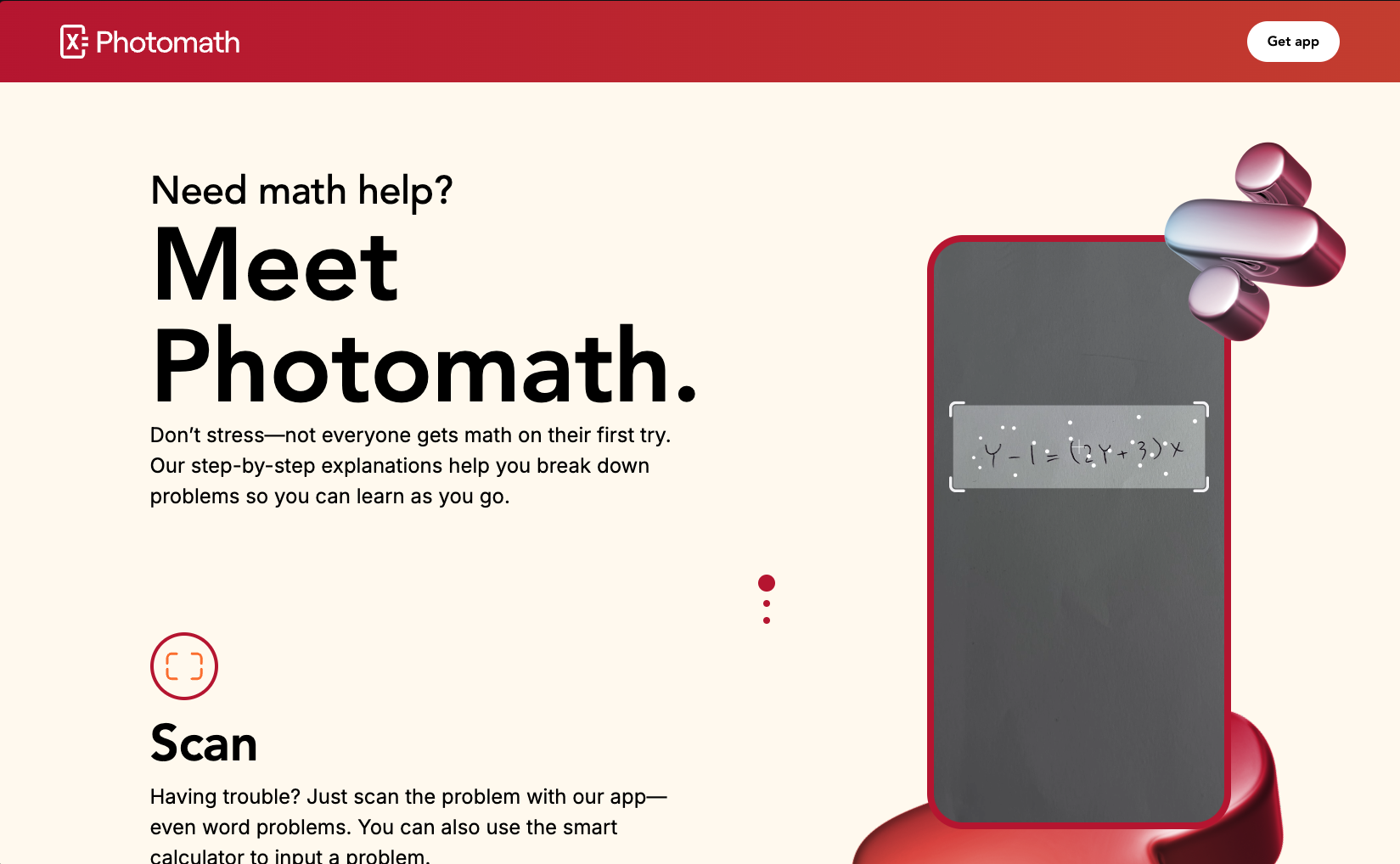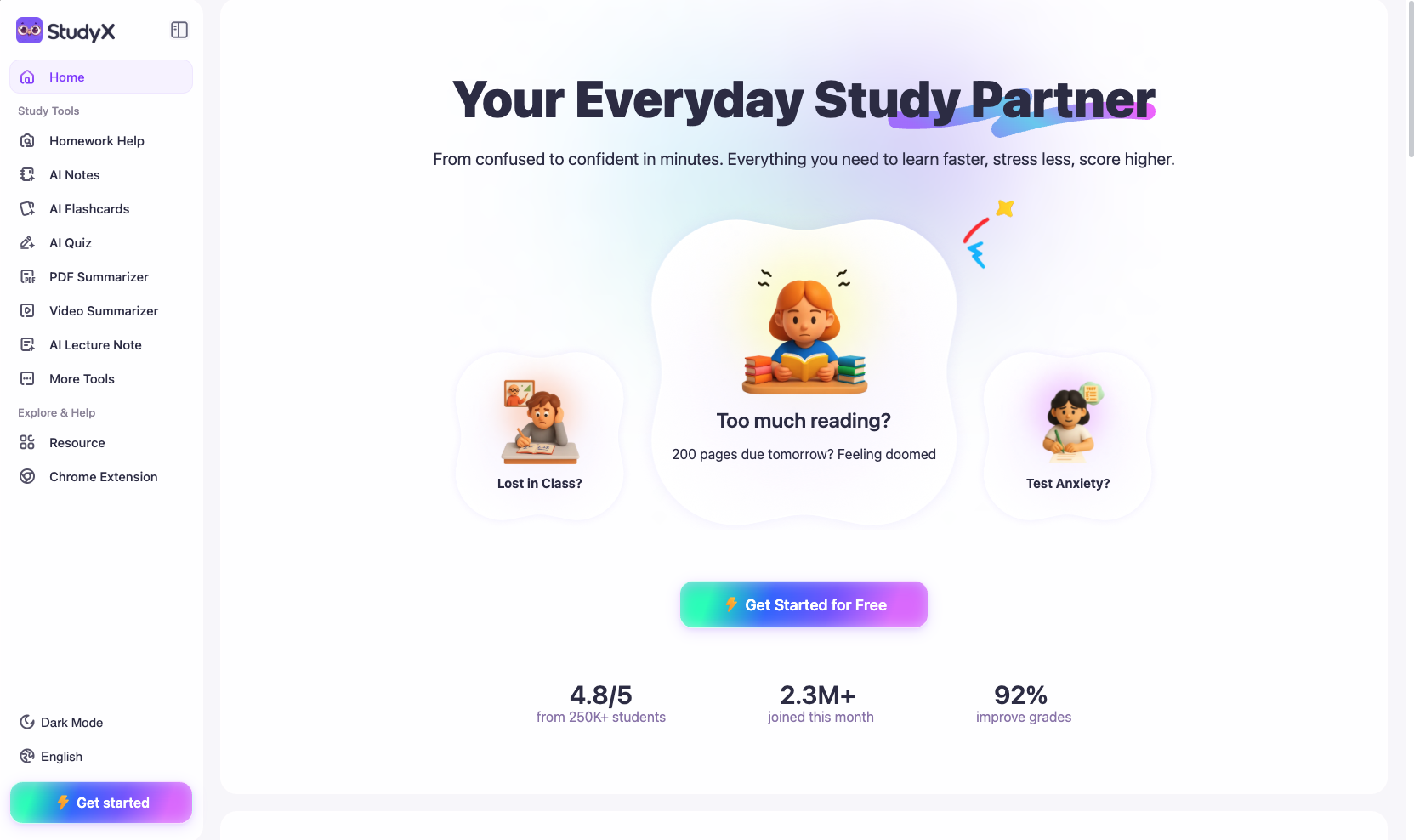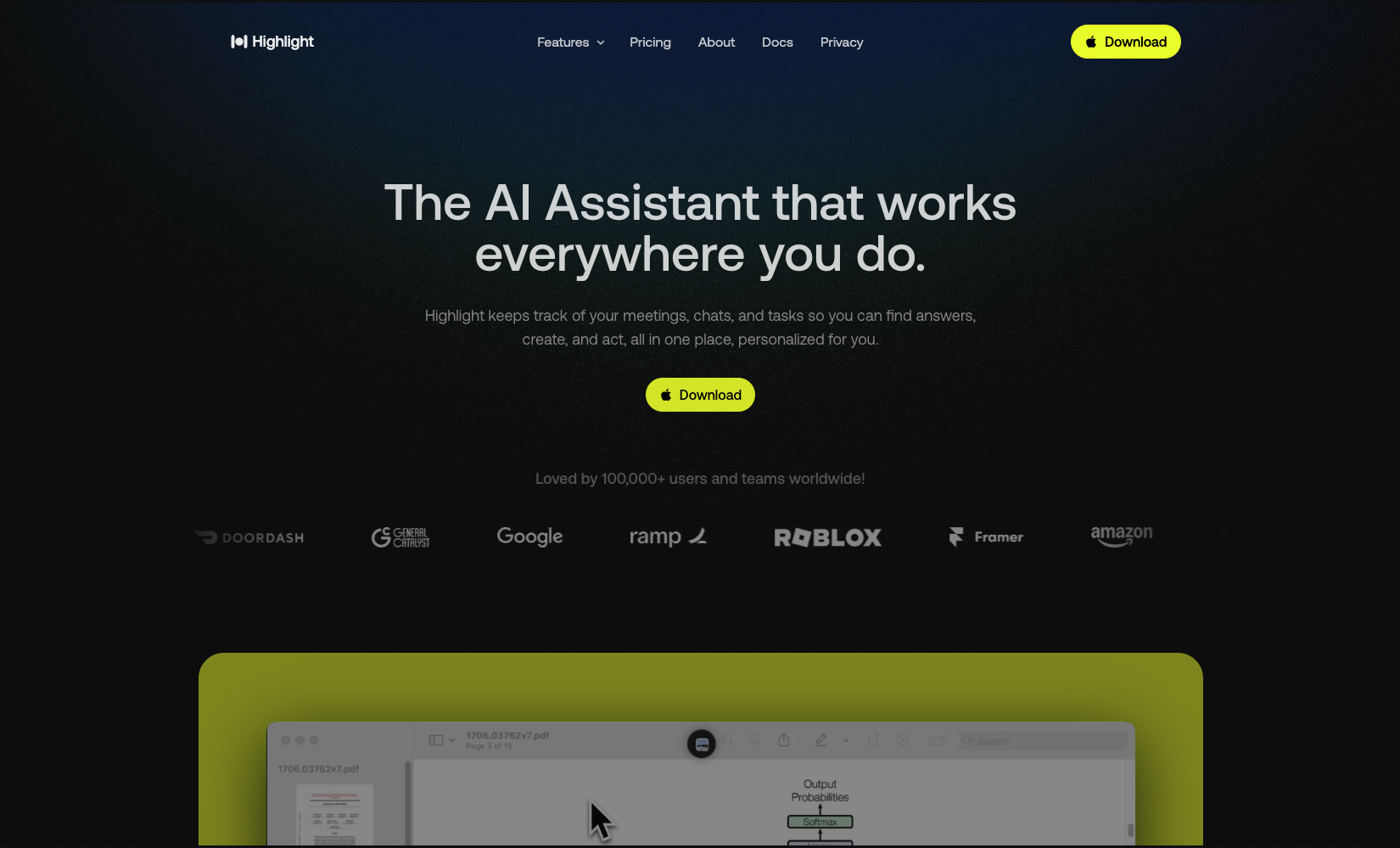Best AI Homework Tools for Instant Study Help
Students today have access to a range of digital resources for their studies. With the rise of artificial intelligence, new tools are changing how questions are answered and assignments are completed. These technologies are designed to provide quick help and clear explanations.
For anyone searching for instant answers or step-by-step solutions, AI-powered homework tools have become a popular choice. These tools are especially useful for subjects that require detailed problem solving or clear explanations.
The real value? Time saved. Students using AI homework tools report saving 2–3 hours per week on research and problem-solving tasks—time that can be redirected toward deeper learning, creative projects, or simply getting better sleep. That's roughly 100+ hours per semester that shifts from mechanical work to meaningful thinking.
What is an AI homework helper?
An AI homework helper is a computer program that uses artificial intelligence to assist students with their homework across subjects like math, science, writing, and languages. These tools analyze questions and generate solutions, explanations, or summaries using technologies like natural language processing and machine learning.
AI homework helpers work by breaking down the meaning of a question and applying subject-specific logic to create responses. They can provide answers, show step-by-step solutions, and explain the reasoning behind each step. Most homework AI tools are designed to give instant feedback without requiring scheduled appointments with tutors or teachers.
ROI of AI homework assistance
Let's break down the numbers. Traditional tutoring costs $40–$80 per hour, with most students needing 2–3 sessions weekly. That's $320–$480 monthly. Compare this to AI tools:
| Cost Factor | Traditional Tutoring | AI Homework Tools |
|---|---|---|
| Monthly cost | $320–$480 | $0–$20 |
| Availability | Limited hours | 24/7 |
| Response time | Schedule dependent | Instant |
| Subject coverage | Tutor expertise only | Multi-subject |
| Annual savings | — | $3,000–$5,500 |
The math is pretty compelling—and that's before factoring in travel time or scheduling flexibility.
Common examples of AI homework helpers
Though advanced AI tutors that can handle any subject perfectly don't exist yet, you've likely encountered basic forms of homework assistance technology before. At the simplest level, these tools use algorithms trained on educational data to perform tasks like solving equations, checking grammar, or explaining concepts.
Some of the most common examples of AI for homework include:
- ChatGPT: Uses large language models to generate explanations and answers across multiple subjects
- Photomath: Uses computer vision to read math problems from photos and show step-by-step solutions
- Grammarly: Uses natural language processing to check grammar and improve writing clarity
- Khan Academy's Khanmigo: Uses conversational AI to guide students through problems using the Socratic method
- Highlight AI: Works as a desktop assistant across all applications on Mac and Windows computers and provides context-aware help by recognizing what appears on screen and offering instant assistance through its "magic dot" feature
Why students use AI homework tools
AI homework tools offer several practical advantages that make them appealing to students facing academic challenges. These tools address common study obstacles that students encounter during their educational journey.
- 24/7 availability: Unlike human tutors or teacher office hours, AI homework solver tools work at any time of day. Students can get help with late-night study sessions or weekend assignments without waiting for school hours.
- Personalized explanations: Many AI tools adjust their explanations based on the complexity of the question or the student's apparent understanding level. If a concept remains unclear, the AI can provide simpler explanations or alternative approaches.
- Step-by-step breakdowns: Rather than just providing final answers, most homework helper AI tools show the process used to reach solutions. This approach helps students understand methodology and reasoning.
- Multi-subject support: Most general-purpose AI homework helpers can handle questions across different academic areas, from mathematics and science to literature and history.
These tools work best as learning supplements rather than replacements for critical thinking and independent study.
Common challenges students face with AI tools
Even the best AI homework helpers come with predictable friction points. Here's what we see most often—and how to work around them:
Context switching fatigue: Jumping between your notes app, browser tabs, and AI tools breaks your flow. Students report losing 5–10 minutes per session just navigating between applications.
Solution: Look for tools that work where you already are. Context is key—your AI should understand what you're looking at without requiring you to copy-paste everything.
Over-reliance concerns: It's easy to lean too heavily on AI explanations without building your own problem-solving muscles.
Solution: Use the 70/30 rule. Attempt problems independently 70% of the time, use AI assistance for the remaining 30% when you're truly stuck.
Quality inconsistency: AI responses vary in accuracy and depth, especially for complex or nuanced topics.
Solution: Always cross-reference AI explanations with your textbook or class materials. Think of AI as a study buddy, not the final authority.
Best free AI homework tools across every subject
Several free AI-powered homework helpers are available to support students across different academic subjects. Each tool offers unique features designed for specific types of questions and learning preferences.
Comprehensive tool comparison
| Tool | Best For | Free Tier Limits | Unique Feature | Integration Level |
|---|---|---|---|---|
| ChatGPT | General explanations | 20 messages/3 hours | Conversational follow-ups | Web-based |
| Photomath | Math problems | Unlimited basic solving | Camera recognition | Mobile app |
| Grammarly | Writing improvement | Basic grammar checks | Real-time suggestions | Browser extension |
| StudyX | Multi-subject | 5 questions/day | File uploads | Web platform |
| Highlight AI | Cross-app assistance | No daily limits | Works in any app | Desktop native |
ChatGPT for conversational tutoring
What it does: ChatGPT handles open-ended questions across subjects like science, history, literature, and mathematics. The conversational interface allows students to ask follow-up questions and request clarification on confusing topics. The tool excels at explaining complex concepts in simpler terms and providing multiple perspectives on academic topics.
Success metrics to track: Measure your understanding by asking ChatGPT to quiz you on the concepts it just explained. If you can answer correctly without looking back, you've internalized the material.

Photomath for visual math solving
What it does: Photomath specializes in mathematics by using smartphone cameras to read handwritten or printed math problems. The app displays each step involved in solving equations, making the mathematical process transparent. It covers topics from basic arithmetic through calculus.
Pro tip: After Photomath solves a problem, cover the solution and try working through it yourself using only the first step as a hint. This builds pattern recognition without creating dependency.

Grammarly for writing improvement
What it does: Grammarly focuses on writing assistance by checking grammar, spelling, and punctuation in essays and assignments. The tool provides real-time suggestions for improving sentence structure and clarity. It also offers feedback on tone and writing style.
Integration consideration: Grammarly works well in Google Docs and Microsoft Word, but can feel clunky when writing in other applications or note-taking tools.

StudyX for multi-subject support
What it does: StudyX provides a homework helper free platform that handles multiple subjects and includes features for uploading files and organizing study materials. Students can track problems and take notes within the same interface.

Highlight AI for cross-application assistance
What it does: Highlight AI works as a desktop assistant across all applications on Mac and Windows computers. The tool provides context-aware help by recognizing what appears on screen and offering instant assistance. Students can access AI-powered support in any application without switching between tabs or copying content between programs enabling them to learn, research and write faster.
Why this matters: Whether you're stuck on a concept in your notes app, need to understand a research paper in your browser, or want to improve writing in any document—just ask your Highlight assistant. No setup, no switching apps, no breaking your flow.

How to choose the right AI study helper
Selecting an appropriate AI study helper depends on your specific academic needs, subject focus, and privacy preferences. Different tools excel in different areas, so understanding their strengths helps in making informed decisions.
Decision framework checklist
Use this step-by-step evaluation process:
1. Identify your primary use case
- Math problem solving
- Writing assistance
- Research and explanations
- Multi-subject support
- Study organization
2. Assess your workflow preferences
- Comfortable switching between apps
- Prefer working in one environment
- Need mobile access
- Require offline functionality
3. Evaluate privacy requirements
- Comfortable with cloud processing
- Prefer local data handling
- Need to comply with school policies
- Concerned about data retention
4. Test integration compatibility
- Works with your note-taking app
- Compatible with your writing tools
- Supports your research workflow
- Fits your collaboration needs
5. Match tools to your subject needs
Some AI helpers specialize in particular subjects while others cover broad academic areas. Math-focused tools like Photomath excel at solving equations and showing mathematical steps, while general-purpose assistants handle diverse topics from science to literature. Consider which subjects present the greatest challenges in your coursework.
Subject-specific recommendations:
- STEM fields: Prioritize tools with strong mathematical reasoning and formula support
- Humanities: Look for assistants that excel at analysis, interpretation, and writing feedback
- Languages: Choose tools with translation capabilities and grammar checking
- Research-heavy courses: Focus on tools that can process and summarize multiple sources
- Understand free version limitations
Free versions of homework AI tools often include restrictions on daily usage, available features, or response complexity. Some platforms limit the number of questions per day or reserve advanced features for paid subscribers. Review these limitations to avoid interruptions during important study sessions.
- Review privacy and data policies
AI homework tools handle student questions and academic work differently. Some tools process information locally on your device, while others send data to cloud servers. Desktop-first tools like Highlight AI keep information on your computer, while web-based platforms may store or analyze user input for service improvement.
Privacy evaluation criteria:
- Where is your data processed? (Local vs. cloud)
- How long is information retained?
- Can you delete your data?
- Are conversations used for training?
- What happens to uploaded files?
Step-by-step guide to getting instant homework help
1. Input your question clearly
Most AI homework helpers accept questions through typing, photo upload, or copy-paste methods. Clear formatting improves response quality - use proper mathematical notation, complete sentences, and specific subject terminology when possible.
Optimization tips:
- Include relevant context ("This is for my AP Chemistry class")
- Specify the type of help needed ("Explain the concept" vs. "Check my work")
- Attach or describe any relevant materials or constraints
2. Review the generated solution
After processing your question, the AI provides an initial response within seconds. The tool identifies key concepts, applies relevant algorithms or knowledge, and generates explanations based on its training data.
Quality check indicators:
- Does the explanation match your course level?
- Are the steps logically sequenced?
- Does the final answer seem reasonable?
- Are key terms defined appropriately?
3. Examine the reasoning process
Quality homework helper AI tools display the steps taken to reach their conclusions. This breakdown shows the logical progression from question to answer, helping you understand the methodology rather than just memorizing results.
4. Ask clarifying questions
Use follow-up questions to address confusing steps or request alternative explanations. Most conversational AI tools can provide different approaches to the same problem or explain concepts using simpler language.
Effective follow-up strategies:
- "Can you explain step 3 in simpler terms?"
- "What would happen if I changed this variable?"
- "Show me a similar example with different numbers"
- "Why is this method better than [alternative approach]?"
5. Save important solutions
Many platforms allow saving or exporting solutions for future reference. Organizing these materials creates a personal study resource for exam preparation and concept review.
Using AI homework helpers responsibly
Responsible use of AI homework assistance focuses on learning enhancement rather than academic shortcuts. These practices support educational growth while maintaining academic integrity.
- Verify AI responses: AI-generated answers can contain errors or incomplete information. Cross-checking solutions against textbooks, class notes, or other reliable sources helps identify mistakes and reinforces learning.
- Follow citation guidelines: Some educational institutions require students to acknowledge AI assistance in their work. Understanding and following your school's policies on AI use prevents academic integrity violations.
- Combine with traditional study methods: AI explanations work best when integrated with lecture notes, textbook readings, and independent problem-solving practice. This combination creates more comprehensive understanding than relying solely on AI assistance.
- Balance screen time with independent thinking: Extended use of digital tools can lead to over-dependence on technology. Alternating between AI-assisted study and independent work maintains critical thinking skills.
Academic integrity best practices
Here's a practical framework for staying on the right side of academic honesty:
Green light scenarios:
- Using AI to explain concepts you don't understand
- Getting help with problem-solving methodology
- Checking your work for errors or improvements
- Generating practice problems for self-testing
Yellow light scenarios (check your school's policy):
- Using AI to brainstorm essay topics or outlines
- Getting feedback on draft work before submission
- Using AI to help with research and source analysis
- Collaborating with AI on group projects
Red light scenarios:
- Submitting AI-generated work as your own
- Using AI during closed-book exams or assessments
- Having AI complete assignments without your input
- Bypassing learning objectives through AI shortcuts
Success metrics for responsible AI use
Track these indicators to ensure you're building knowledge, not just completing assignments:
- Learning retention: Can you solve similar problems without AI help after a week?
- Concept transfer: Can you apply what AI taught you to new, related problems?
- Explanation ability: Can you teach the concept to someone else in your own words?
- Time to independence: Are you needing less AI help over time for similar topics?
How Highlight AI enhances homework workflows
Highlight AI functions as an intelligent desktop assistant that’s available wherever you work on Mac and Windows—Docs, PDFs, slides, browsers, and calls—so you don’t have to switch tabs or craft prompts.
The assistant understands what’s on your screen and provides context-aware summaries, explanations, and edits. It recognizes selected text, screenshots, and open windows to deliver relevant help instantly, keeping you in flow.
Real workflow impact: Students report eliminating 15–20 app switches per study session. Those micro‑interruptions add up to cognitive load. When your assistant understands what you’re looking at without you having to explain it, you stay in a flow state longer.
For collaborative study sessions, Highlight AI transcribes meetings from platforms like Zoom, Slack, Microsoft Teams, and Google Meet. These transcriptions become searchable notes that students can reference when reviewing group discussions or assignment details.
Study group optimization: Instead of one person frantically taking notes while others focus on discussion, Highlight AI captures everything automatically. Post‑session, everyone gets the same comprehensive record with action items and key concepts highlighted.
The cross‑application functionality eliminates the need for manual setup or account management. Highlight AI processes information locally on the user's device, providing privacy protection while delivering seamless integration with existing study tools and educational resources.
Integration advantages over traditional tools
| Traditional Approach | Highlight AI Approach | Time Saved |
|---|---|---|
| Copy question → Open browser → Paste → Get answer → Copy back | Summon assistant → Get instant help | 30–45 seconds per query |
| Switch to note app → Find relevant section → Return to work | AI sees your context automatically | 15–20 seconds per reference |
| Manual meeting notes → Type up later → Share with group | Auto-transcription → Instant sharing | 45–60 minutes per session |
The compound effect: These time savings multiply across your entire academic workflow. Over a semester, that's 20–30 hours returned to actual learning instead of administrative overhead.
Frequently asked questions about AI homework helpers
Will using AI homework helpers trigger plagiarism detection software?
Most plagiarism detection systems cannot identify when students use AI homework helpers for learning assistance, but they may flag content that is copied directly from AI responses without modification. Academic integrity policies typically focus on proper attribution and original thinking rather than the tools used for learning support.
Practical guidance: Think of AI as a research assistant, not a ghostwriter. If you wouldn't cite a conversation with a tutor, you probably don't need to cite AI-assisted learning. But if you're directly incorporating AI-generated text or solutions, that's different territory.
Can I use multiple AI homework tools together effectively?
Students commonly combine different AI tools for various subjects and tasks, such as using Photomath for mathematics and Grammarly for writing assignments. Cross-application tools like Highlight AI allow access to multiple AI helpers within a single workflow without switching between different platforms or browser tabs.
Optimization strategy: Start with one primary tool that covers 80% of your needs, then add specialized tools for specific gaps. Too many tools create decision fatigue and workflow fragmentation.
Do AI homework helpers work without internet access?
Most AI homework tools require internet connectivity to access their machine learning models and generate responses. Some applications may offer limited offline functionality for note-taking or viewing previously saved content, but AI-powered features typically need online access.
Offline preparation tips:
- Download key explanations and solutions while connected
- Use AI to create study guides you can reference offline
- Generate practice problems with solutions for offline review
- Save important formulas and concept summaries locally
How can I protect my homework data when using AI tools?
AI tools implement different approaches to data handling and privacy protection. Desktop-based tools that process information locally provide stronger privacy protection than cloud-based alternatives that may store or analyze user input on remote servers.
Privacy protection checklist:
- Review data retention policies before using new tools
- Avoid uploading sensitive personal information
- Use tools that process data locally when possible
- Regularly clear chat histories and saved content
- Check if your school has approved AI tool lists
- Understand what data is used for model training
Bottom line: Your academic work deserves the same privacy protection as your personal information. Choose tools that respect that boundary.

